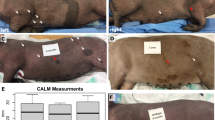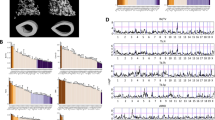Abstract
A comprehensive analysis of initial thymus size and involution rate has not been quantitated for different genetic backgrounds of mice, thus genetic linkage analysis of thymic involution has not been possible. Here, we have used a mathematical method to analyze the age-related decline in thymocyte count in C57BL/6 and DBA/2 mice and have observed that thymic involution could be best fit with a negative exponential curve N(t)=β0 × exp(−β1t), where t represents the age (day). This regression model was applied to C57BL/6 × DBA/2 (B × D) recombinant inbred strains of mice to identify the genetic loci influencing age-related thymic involution. There was a dramatic genetic effect of B and D alleles on thymocyte count at young age and the age-related thymic involution rate. The strongest quantitative trait loci (QTL) influencing the rate of thymic involution were mapped to mouse chromosome (Chr) 9 (D9Mit20 at 62 cM) and Chr 10 (D10Mit61 at 32 cM). The strongest QTLs influencing the initial thymocyte count were mapped to ChrX (DXMit324 at 26.5 cM) and Chr 3 (D3Mit127 at 70.3 cM). The present study suggests that the initial thymus size and the rate of thymic involution may be influenced by a relatively small number of genetic loci.
This is a preview of subscription content, access via your institution
Access options
Subscribe to this journal
Receive 6 digital issues and online access to articles
$119.00 per year
only $19.83 per issue
Buy this article
- Purchase on Springer Link
- Instant access to full article PDF
Prices may be subject to local taxes which are calculated during checkout



Similar content being viewed by others
Abbreviations
- B × D:
-
C57BL/6J × DBA/2J
- Chr:
-
chromosome
- LRS:
-
likelihood ratio statistics
- QTL:
-
quantitative trait loci
- RI:
-
recombinant inbred
References
Boyd E . The weight of the thymus gland in health and disease. Am J Dis Child 1932; 43: 1162–1214.
Aspinall R, Andrew D . Thymic involution in aging. J Clin Immunol 2000; 20: 250–256.
Kelley KW, Meier WA, Minshall C et al. Insulin growth factor-I inhibits apoptosis in hematopoietic progenitor cells. Implications in thymic aging. Ann NY Acad Sci 1998; 840: 518–524.
Maraskovsky E, Teepe M, Morrissey PJ et al. Impaired survival and proliferation in IL-7 receptor-deficient peripheral T cells. J Immunol 1996; 157: 5315–5323.
Zhou T, Edwards III CK, Mountz JD . Prevention of age-related T cell apoptosis defect in CD2-fas-transgenic mice. J Exp Med 1995; 182: 129–137.
Li L, Hsu H-C, Grizzle WE et al. Cellular mechanism of thymic involution. Scand J Immunol 2002; in press.
Bar-Dayan Y, Afek A, Goldberg I, Kopolovic J . Proliferation, apoptosis and thymic involution. Tissue Cell 1999; 31: 391–396.
Steinmann GG, Klaus B, Muller-Hermelink HK . The involution of the ageing human thymic epithelium is independent of puberty. A morphometric study. Scand J Immunol 1985; 22: 563–575.
Tosi P, Kraft R, Luzi P et al. Involution patterns of the human thymus. I Size of the cortical area as a function of age. Clin Exp Immunol 1982; 47: 497–504.
Hsu HC, Mountz JD, Williams RW et al. Age-related change in thymic T-cell development is associated with genetic loci on mouse chromosomes 1, 3, and 11. Mech Ageing Dev 2002; 123: 1145–1158.
Pantelouris EM . Absence of thymus in a mouse mutant. Nature 1968; 217: 370–371.
Heinlein UA, Wille W . Evidence for a thymus-affecting, recessive mouse gene (sty) located between the staggerer (sg) and short-ear (se) loci on chromosome 9. Cell Biol Int Rep 1992; 16: 1247–1250.
Aspinall R . Age-associated thymic atrophy in the mouse is due to a deficiency affecting rearrangement of the TCR during intrathymic T cell development. J Immunol 1997; 158: 3037–3045.
von Freeden-Jeffry U, Vieira P, Lucian LA, McNeil T, Burdach SE, Murray R . Lymphopenia in interleukin (IL)-7 gene-deleted mice identifies IL-7 as a nonredundant cytokine. J Exp Med 1995; 181: 1519–1526.
Ortman CL, Dittmar KA, Witte PL, Le PT . Molecular characterization of the mouse involuted thymus: aberrations in expression of transcription regulators in thymocyte and epithelial compartments. Int Immunol 2002; 14: 813–822.
Jones BC, Sarrieau A, Reed CL, Azar MR, Mormede P . Contribution of sex and genetics to neuroendocrine adaptation to stress in mice. Psychoneuroendocrinology 1998; 23: 505–517.
Jaffrezic F, Pletcher SD . Statistical models for estimating the genetic basis of repeated measures and other function-valued traits. Genetics 2000; 156: 913–922.
Pletcher SD, Geyer CJ . The genetic analysis of age-dependent traits: modeling the character process. Genetics 1999; 153: 825–835.
Pletcher SD, Jaffrezic F . Generalized character process models: estimating the genetic basis of traits that cannot be observed and that change with age or environmental conditions. Biometrics 2002; 58: 157–162.
Atchley WR, Zhu J . Developmental quantitative genetics, conditional epigenetic variability and growth in mice. Genetics 1997; 147: 765–776.
Luft AR, Skalej M, Schulz JB et al. Patterns of age-related shrinkage in cerebellum and brainstem observed in vivo using three-dimensional MRI volumetry. Cereb Cortex 1999; 9: 712–721.
Rogers A, Hannon RA, Eastell R . Biochemical markers as predictors of rates of bone loss after menopause. J Bone Miner Res 2000; 15: 1398–1404.
Sempowski GD, Gooding ME, Liao HX, Le PT, Haynes BF. T cell receptor excision circle assessment of thymopoiesis in aging mice. Mol Immunol 2002; 38: 841–848.
Lembertas AV, Fisher JS, Warden CH, Wen PZ, Xia YR, Lusis AJ . A locus on the X chromosome is linked to body length in mice. Mamm Genome 1996; 7: 171–173.
Rance KA, Hill WG, Keightley PD . Mapping quantitative trait loci for body weight on the X chromosome in mice. I. Analysis of a reciprocal F2 population. Genet Res 1997; 70: 117–124.
Brockmann GA, Haley CS, Renne U, Knott SA, Schwerin M . Quantitative trait loci affecting body weight and fatness from a mouse line selected for extreme high growth. Genetics 1998; 150: 369–381.
Liu X, Bunger L, Keightley PD . Characterization of a major X-linked quantitative trait locus influencing body weight of mice. J Hered 2001; 92: 355–357.
Moody DE, Pomp D, Nielsen MK, Van Vleck LD . Identification of quantitative trait loci influencing traits related to energy balance in selection and inbred lines of mice. Genetics 1999; 152: 699–711.
Havelkova H, Kosarova M, Krulova M, Demant P, Lipoldova M . T-cell proliferative response is controlled by loci Tria4 and Tria5 on mouse chromosomes 7 and 9. Mamm Genome 1999; 10: 670–674.
Clemens KE, Churchill G, Bhatt N, Richardson K, Noonan FP . Genetic control of susceptibility to UV-induced immunosuppression by interacting quantitative trait loci. Genes Immun 2000; 1: 251–259.
Roper RJ, Weis JJ, McCracken BA et al. Genetic control of susceptibility to experimental Lyme arthritis is polygenic and exhibits consistent linkage to multiple loci on chromosome 5 in four independent mouse crosses. Genes Immun 2001; 2: 388–397.
Blankenhorn EP, Butterfield RJ, Rigby R et al. Genetic analysis of the influence of pertussis toxin on experimental allergic encephalomyelitis susceptibility: an environmental agent can override genetic checkpoints. J Immunol 2000; 164: 3420–3425.
Miller RA, Chrisp C, Jackson AU, Galecki AT, Burke DT . Coordinated genetic control of neoplastic and nonneoplastic diseases in mice. J Gerontol A Biol Sci Med Sci 2002; 57: B3–B8.
Jackson AU, Galecki AT, Burke DT, Miller RA . Mouse loci associated with life span exhibit sex-specific and epistatic effects. J Gerontol A Biol Sci Med Sci 2002; 57: B9–B15.
Anderton SM, Wraith DC . Selection and fine-tuning of the autoimmune T-cell repertoire. Nat Rev Immunol 2002; 2: 487–498.
Shevach EM . Regulatory T cells in autoimmmunity*. Annu Rev Immunol 2000; 18: 423–449.
Seddon B, Mason D . The third function of the thymus. Immunol Today 2000; 21: 95–99.
George AJ, Ritter MA . Thymic involution with ageing: obsolescence or good housekeeping? Immunol Today 1996; 17: 267–272.
Grizzle WE, Mountz JD, Yang P-A et al. B × D recombinant inbred mice represents a novel T-cell mediated immune response tumor model. Int J Cancer 2002; 101: 270–279.
Akaike H . A new look at the statistical model identification. IEEE Trans Autom Control 1974; AC-19: 716–723.
Manly KF, Olson JM . Overview of QTL mapping software and introduction to map manager QT. Mamm Genome 1999; 10: 327–334.
Manly KF, Cudmore Jr RH, Meer JM . Map Manager QTX, cross-platform software for genetic mapping. Mamm Genome 2001; 12: 930–932.
Belknap JK, Mitchell SR, O'Toole LA, Helms ML, Crabbe JC . Type I and type II error rates for quantitative trait loci (QTL) mapping studies using recombinant inbred mouse strains. Behav Genet 1996; 26: 149–160.
Churchill GA, Doerge RW . Empirical threshold values for quantitative trait mapping. Genetics 1994; 138: 963–971.
Manly KF . A Macintosh program for storage and analysis of experimental genetic mapping data. Mamm Genome 1993; 4: 303–313.
Williams RW, Gu J, Qi S, Lu L . Release 1 of the BXN Genotype Database: the genetic structure of recombinant inbred mice: High-resolution consensus maps for complex trait analysis. 2001, 〈http://nervenet.org/papers/bxn.html〉.
Williams RW, Gu J, Qi S, Lu L . The genetic structure of recombinant inbred mice: high-resolution consensus maps for complex trait analysis. Genome Biol 2001; 2: RESEARCH0046.
Taylor BA, Wnek C, Kotlus BS, Roemer N, MacTaggart T, Phillips SJ . Genotyping new B × D recombinant inbred mouse strains and comparison of B × D and consensus maps. Mamm Genome 1999; 10: 335–348.
Acknowledgements
We thank Dr F Hunter for critical review of the manuscript and Ms Carol Humber for excellent secretary work. This work is supported by NIH Grants R01 AG 16653, N01 AR 6-2224, and CA 20408, and a Birmingham VAMC Merit Review Grant. Huang-Ge Zhang is a recipient of Arthritis Foundation Investigator Award.
Author information
Authors and Affiliations
Corresponding author
Rights and permissions
About this article
Cite this article
Hsu, HC., Zhang, HG., Li, L. et al. Age-related thymic involution in C57BL/6J × DBA/2J recombinant-inbred mice maps to mouse chromosomes 9 and 10. Genes Immun 4, 402–410 (2003). https://doi.org/10.1038/sj.gene.6363982
Published:
Issue Date:
DOI: https://doi.org/10.1038/sj.gene.6363982
Keywords
This article is cited by
-
Sexual dimorphism in rat thymic involution: a correlation with thymic oxidative status and inflammation
Biogerontology (2019)
-
Cooperative interaction of BMP signalling and Foxn1 gene dosage determines the size of the functionally active thymic epithelial compartment
Scientific Reports (2017)
-
The immune profile associated with acute allergic asthma accelerates clearance of influenza virus
Immunology & Cell Biology (2014)
-
Genome-wide analysis in Drosophila reveals age-specific effects of SNPs on fitness traits
Nature Communications (2014)



